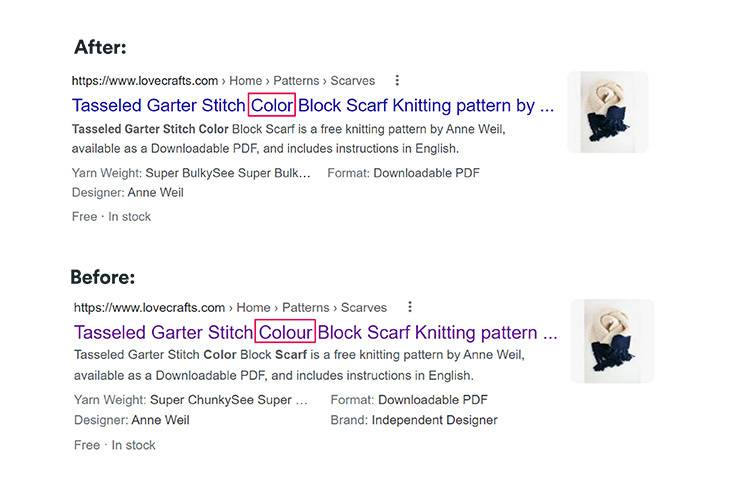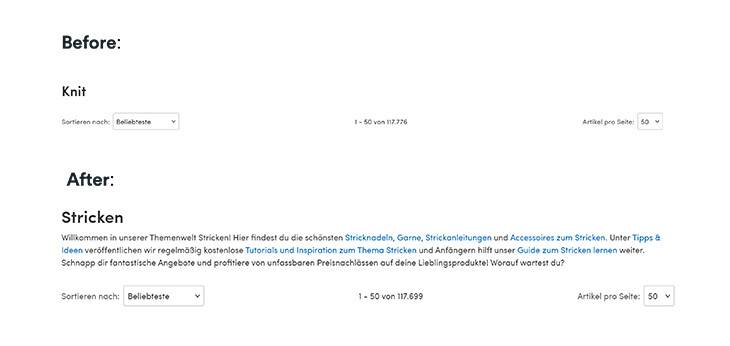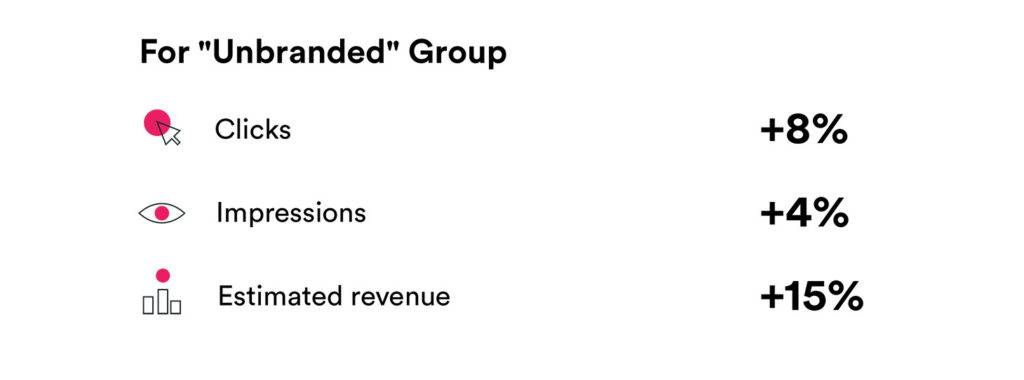The challenge
LoveCrafts is a global community for makers, uniting knitters, crocheters, sewists, quilters, embroiderers, and much more. They inspire crafters to feel connected to other makers, helping them find every little thing they might need, such as crochet patterns or embroidery kits, through one global platform.
LoveCrafts operates in several different markets. As a result, we have to consider the localisation of on-page content.
This can be difficult at scale because pages can often be templated, including on-page elements, copy and URL structures.
As a result, spelling or translations can often suffer, both not meeting the needs of Google and the customer in the process. Partly because of this, it can be expensive to invest in rectifying localisation issues.
We knew localisation was an opportunity for LoveCrafts and our job was to find a way to overcome these barriers while proving the value of investing in localisation. Reliably measuring the impact of any changes we implemented would be critical.
This is why we used SEOcausal. Our process can tie back incremental traffic and revenue increases to deliver interventions that can help build business cases for further investment.
Here it is in action.
What did we test?
For one test, we changed the UK spelling of ‘colour’ to the US version ‘color’, for the US market and vice versa to ensure the correct localised spelling was used in the right market.
We believed this could positively impact CTR, as people should see the correct spelling mirrored to them and Google may place more weight on the localised spelling when ranking pages.
The test involved changing the title tags to 874 PLPs in the US and 1,682 PLPs in the UK. We then measured the impact against a control set made up of a combination of PLP and PDP pages across the Lovecraft domain.

The test split allows us to measure the impact of our changes accurately. It compares changes in an uplift within the test group against a baseline control of URLs, where we didn’t make changes.
In addition, we also ran another localisation test where we converted English heading tags into German on a German site. No surprises here; we measured a direct, consequential positive uplift!

What are the results?
We learnt that localising title tags can positively impact both clicks and average position, putting hard metrics behind our recommendations and justifying further investment in localisation.
Out of the metrics we analysed, non-branded clicks improved by 8% and average position improved by 6%, demonstrating a statistically significant uplift for the US market.
Not only that, this change to localisation had an estimated 15% increase on revenue, demonstrating how even minor tweaks can have a significant impact on the hardest of metrics.

What does this tell us?
Simply put, we learnt that localising on-page elements like title and heading tags and content can go a long way in improving performance. Importantly we were able to demonstrate a quantifiable uplift to justify then implementing changes site-wide.
Helping both Google and users better understand that your site is relevant for a particular market in a localised manner is a no-brainer and warrants investment in getting localisation on point. Even small tweaks can, when made at scale, lead to significant performance uplifts over time.
This is yet another example of how SEOcausal, our causal impact model, can help our clients showcase the impact of implementations and get buy-in from stakeholders.
Don’t just take our word for it:
“Our hunch was that localising spelling would lead to an improvement in organic performance, but we needed the data to back this up before we could get buy-in from other teams. Only with this hard data provided by Builtvisible could we actually prove this and get these changes implemented more widely across our sites.”
Ailish Fowler, Head of SEO, LoveCrafts
